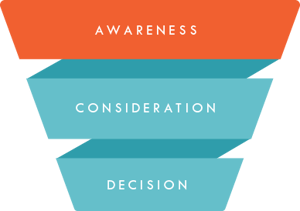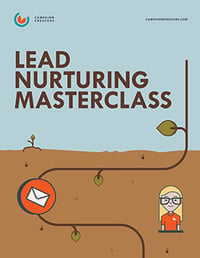Welcome back to the Lead Nurturing Masterclass, and your very last lesson! We are concluding this masterclass with some final best practices and useful reminders to take with you as you build your lead nurturing strategy.
Best Practices for Nurturing Emails
Pacing Yourself
As important as regularity is to the success of your email nurturing campaign, it is wise to refrain from creating burnout for your recipients by over-emailing. This can be caused by enrolling a lead in too many campaigns simultaneously, or simply not spacing out sends sufficiently. Good workflows and thorough A/B testing can be key in preventing this.
Additionally, though email frequency should generally be timed to the average length of your sales cycle, keep in mind that the optimal timing for your strategy will depend on the type of campaign being implemented. Frequency can range from about once a week to once every month and a half!
![]()
For customer retention or re-engagement purposes, for example, you may choose to send additional emails to supplement your regular newsletter in particular cases, such as when relevant new offers or products become available, when customers interact with your company in a particular way, or when new strategies offer opportunities to drive conversions.
For nurturing leads who have made initial contact with your sales team, in contrast, it may be best to ask the sales team itself for advice, as your representatives are the ones in close contact with the recipients. Ultimately, pacing and variety of content are two potent factors that must work together for strong open and click-through rates.
Don’t Forget Your History with Your Leads
Tying in with consistency in tone and frequency is the crucial idea that you must remember the previous emails that a lead has received from your company. After all, nurturing is about establishing a relationship with leads. If a lead nurturing series acts as though every email is the first one being sent, with the same offers and phrasing, it can easily come off as uncoordinated and impersonal.
An email following up an on an eBook offer, for instance, can discuss a brand message relevant to the previous email or reference it directly, creating a cohesive narrative around a product or service without simply repeating information. Combined with a detailed email calendar and intermittent emails that request questions or feedback from recipients, this practice will help to cultivate a dynamic that indicates to leads that you’re paying attention to them, rather than simply assigning various team members to robotically fill their inbox with emails.
Keep Multi-Channel Strategy in Mind
While email is a powerful cornerstone of a nurturing strategy, it is most effective when viewed as a pipeline or hub for connecting leads to other content on platforms such as social media and your site. As such, your emails must be coordinated with these platforms to enable an experience that allows leads to move seamlessly between channels. This is why a focus on multi-channel marketing is so important.
Multi-channel marketing is a straightforward term—a strategy in which marketers rely on a mix of channels to distribute content and engage with their audience, from a messaging app to an email campaign to a brick-and-mortar storefront. Effective multi-channel lead nurturing often involves email working alongside social media, dynamic website content, marketing automation, paid retargeting, and sales team outreach.
Despite the fact that 72% of consumers would rather connect with brands and businesses through multichannel marketing, only 14% of organizations say they are currently running coordinated marketing campaigns across all channels. As the core component of your company’s communication with leads, email can play a role in maintaining a consistent tone for multi-channel campaigns, delivering value reliably, and reinforcing other channels.
Lead Nurturing Optimization Best Practices
Don’t “Set It and Forget It”
Complacency is all too common of an issue for marketers, especially with the degree to which modern nurturing campaigns can be automated. Everything from your goals to your KPIs to your lead scoring models need to be systematically looked over. In a fast-evolving sphere where new technology and new tactics are constantly coming into use, standing still, as Lauren Bacall said, is as good as moving backwards.
It is optimal to set monthly or quarterly meetings to examine the progress of your campaigns. Even if the results are positive, however, it is always worth reviewing suggestions and recommendations from your marketing team (and even from your sales team).
Keep Your List Clean
Regularly cleaning your contacts list will prevent you from sending emails, SMS, and other messages to leads who have opted out, marked your emails as spam, or bounced multiple times. Such recipients can mess with analytics and clutter up your contacts.
Removing inactive leads, however, is a step that requires deliberation. It is up to you to define the period of inactivity that deems them necessary to remove from your contacts. It may be wise to send a last “this is your final email” communication to attempt to retain some customers. Prior to this, inactive leads can be re-segmented to receive less frequent emails, perhaps with more appealing offers. For instance, a lead unresponsive to weekly emails with content offers may better engage with monthly, higher-value product offers.
Additionally, keep in mind that bounces and inactive recipients are two distinct issues, and make sure to devote attention to the former. While hard bounces should be removed immediately, soft bounces still carry some potential. Finally, consider purchasing email lists from a trustworthy outside provider (provided the data is useful for targeting your intended audience).
Avoid Making Assumptions
Though common sense and intuition can be useful in constructing elements of a campaign, the proof ultimately lies in the data. This doesn’t necessarily only entail cold, hard numbers. For this reason, both quantitative and qualitative data have their roles to play in analyzing the effectiveness of your nurturing.

Nevertheless, extrapolation can be the downfall of a developing nurturing campaign as market, industry, and even general economic conditions change. Self-confidence is an important asset, but too many marketers choose to dismiss the results measured by their carefully researched metrics based on “gut feeling” or no longer applicable past patterns. Modifying your strategy is not an indicator of failure—on the contrary, it marks success by demonstrating adaptability.
Best Practices for Lead Nurturing Content
Don’t Be Self-Centered
In trying to exhibit a product in a way that seems most appealing to them, many marketers often forget the golden rule: customers care about content that most directly carries value for them, not for you. While highlighting innovation and company reputation can carry advantages, content oriented around pain points will yield far greater results.
When adding information to any content piece, consider whether it is directly relevant to the customer needs. At the end of the day, lead nurturing is not intrinsically about selling product features or a brand image, but the full experience that a client receives when choosing to commit to your company.
Coordination is Key
Coordinating your content across different outlets and platforms can be one of the most difficult aspects of the content strategy. Here are some tips for aligning content creation and publication across all of your major channels.
Map content themes with detailed buyer personas
Consider how your content can support particular personas’ needs using analytics software, social media feedback, industry influencers’ writing, keyword research, etc.
Keep up with your editorial calendar
A must-have asset for organizing your strategy, the calendar should not only set publishing deadlines, but ones for stages like drafts, general planning, routing, and editing. A tool with social sharing scheduling features is ideal for maximizing your content’s visibility.
Communicate consistently
Make sure your teams are interacting regularly both in-person and through digital platforms (which can be made exclusively for communication or incorporate it as a feature, like a CMS) to ensure you are maintaining content quality, answering any potential questions, and staying on deadline.
Determine KPIs and metrics
Some examples include engagement, conversion, referrals/shares, top pages visited, average reading time spent on page, etc.
Make use of content workflow tools
Look for key features like status and productivity tracking, buyer persona templates, editorial calendars, persona templates and content strategy integration, real-time user collaboration and editing, and social media integration.
Use Gated Content (In Moderation)
Experimenting with different types of nurturing content is wise when optimizing your strategy, and some marketers turn to gated content as a means of facilitating value exchange between company and lead. As a fresher, gated content provides a valuable asset in exchange for personal information such as name, email address, company name, etc., and can be applied to a variety of marketing assets like white papers, demos, eBooks, and videos.
Though often discussed in reference to lead generation, gated content can also have a place in nurturing. While content without a gate can be useful in building trust by offering value upfront, gating is optimal when a lead has taken an interest in your company, considered its credibility, and is ready to receive higher-value content. A filled form is a greater indicator of engagement than a click-based “response”, which may be indicative of a passing interest.

Fortunately, gated content can often be created by recycling existing content, even pieces which aren’t major assets, such as blog articles. Just pause to consider when it is best to gate and which type of content is worth gating—scoring and segmentation are vital resources once again in this situation to ensure your audience is ready and willing to participate.
Lead Interaction and Personalization Best Practices
Include Third-Party Data in Lead Scoring
Most marketers making use of behavioral data when creating lead scoring models rely on first party engagement data—free, relatively easily attained information that comes directly from interaction with a consumer, such as personal information, purchase history, engagement with your digital channels (downloads, clicks, visits, etc.), and various other behaviors. First-party data is generally considered more accurate and more reliable than third-party data.

However, this data tends to exclude leads who are closer to the beginning of the buyer’s journey, conducting online research, reading reviews and publications, and devoting attention to industry influencers. After all, the average buyer conducts 60% of their research before reaching out to a company. This is where third party “intent” data comes in.
Despite being collected at a more preliminary stage in the buyer’s journey, third party data—collected based on actions taken by a lead on the broader web outside of your own digital properties—is still very much relevant to lead scoring for nurturing, as it can indicate their buying intent early on and help to inform sales and marketing on how and when to reach out to them further down the line. It can be licensed or purchased from a data collector, but is cost-effective when utilized properly.
Major sources of third party intent data can include:
- Social media
- Online search
- Analyst reports
- Buying guides sites/Software review sites
- Events
- Publication sites
Social media activity in particular has proven highly valuable to collecting third party data. With recent advances in technology, social media activities can be traced to real user identities and relevant contact information, among other data points. With a combination of first and third party data, marketers can create more intricate scoring models.
Send Data Enrichment Emails
Data enrichment emails enable you to learn more about leads over time and inform your segmentation and personalization. These emails contain short surveys that ask the reader to identify with a particular answer that relays information about their demographics, behavior, or otherwise. The answer options are in the form of clickable links, which update the recipient's contact record with the information.
Examples of potential data enrichment questions include simpler ones about company size, job title, or budget, and more complex ones about the types of products in which the lead is interested and the varieties of content they would prefer to receive. Enrichment emails not only provide you with useful information, but may be reassuring to your leads, who will feel that their input is valued.
Personalization as a Holistic Experience
Finally, keep in mind that personalization is a commitment at every stage of the customer life cycle. The stronger and more dynamic your segments, personas, and overall data strategy, the better equipped you are to deliver on this commitment.
Personalized elements in email headings should be followed through on in more substantial areas, like tailored offers or bottom-of-funnel experiences (e.g. landing pages) after a call-to-action has been taken. In designing a holistic personalization experience for any major campaign element, it can be helpful to begin with an end goal and work backwards.
For instance, if the goal is an event registration, begin with considering personalized elements in the registration thank-you page or email, then on the landing page for the event, then the original email inviting leads to register. In addition, address the differences in format and accessibility of elements like emails and site pages between different devices, the two main categories being desktop and mobile. It is important to create versions that accommodate more than one kind of browsing experience and behavior.
Best Practices for Integrating Lead Nurturing into Your Overall Strategy
Consider Overall Brand Experience
When placing your lead nurturing campaign in the context of your overall strategy, brand experience is a significant commitment to stand by. Consistency in design, tone, personas, and themes delivers an appealing brand promise of what leads and customers can expect from their interactions with your company, both within and outside of lead nurturing.
On a more superficial level, consistency involves elements including:
- Color schemes and logo designs
- Typography
- Imagery rules and page design
- Copywriting guidelines
On a deeper level, brand experience delves into your company objectives and values, exemplified by the:
- Mission statement
- Slogan
- Company story
- Primary audiences
- Particularities of your industry
- Definition of the buyer’s journey
Adhering to the guidelines necessary to produce a brand experience that leads find meaningful and engaging requires a combination of automation and “human touch”, depending on the complexity of the elements being managed. These guidelines should be used, maintained, and improved by team members at every step of the marketing funnel, and conveyed to any third-party contractors that contribute to your campaigns.
Keep Filling the Funnel at the Top
Nurturing leads effectively requires them to have been acquired in the first place, via a strong lead generation/capturing strategy. So, it’s important to continue creating more lead capturing opportunities and filling your funnel.

Having examined in depth over the course of this series the major channels around which lead nurturing is built, consider which of these double as channels for lead generation—for example, your company site, emails, blog, and social media. How can these efficiently be used to both generate and nurture? How do posts and pages compete with one another, and how can they be synchronized to create a multi-functional, cohesive set of assets? Explore also how content can be repurposed and upcycled efficiently between generation and nurturing.
In addition, while the focus remains on inbound marketing, a well-rounded generation strategy can, and even should, include an outbound component to amplify inbound efforts and target specific opportunities. Outbound marketing introduces your message and content to prospects through “rented attention” with an obvious call to action, potentially pushing them through the funnel at a faster rate than inbound marketing can. Determining the perfect outbound-inbound mix for your company’s needs will be up to you!
Make Sure Your Sales Team is On Board
It’s been said time and time again, but we keep reiterating the importance of communication between the marketing and sales teams because it continues to hold true! Perhaps the largest mistake marketers can make with lead nurturing is in failing to discuss the launch and progress of their campaigns with the rest of the company. Nurturing affects the bottom of the marketing funnel, and sales has a crucial role to play that needs to be informed by the nurturing strategy.
For example, if sales representatives are talking to these leads simultaneously or after the running of a nurturing email campaign, they should be informed of the content which has been distributed and the timeline it has been distributed over. This allows them to carry a more productive conversation that takes into account what their leads already know.
Ensure that your lead management and nurturing software integrates with the CRM (customer relationship management) software used by your sales team. In the case that integration is not possible, or you do not use a CRM, it is necessary to find another method of sharing primary information about your list of leads, content, segments, and offers.
Congratulations! You have just completed the Lead Nurturing Masterclass. While the previous lessons had exercises to apply what you’ve just learned, we’re confident you’re ready to go forth and start creating your next out-of-this-world lead nurturing campaign today.
It has been a pleasure to have you and we wish you the best of luck in your lead nurturing endeavors. Come back anytime, and be sure to tell your friends about us!



